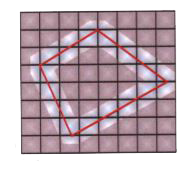Describe the method in steps to find the area of an irregular lamina using a graph paper.
To find the area of an irregular lamina using graph paper, follow these steps:
1. Gather Materials: Obtain a piece of graph paper and the irregular lamina whose area you want to measure.
2. Place the Lamina: Position the irregular lamina on top of the graph paper so that it is fully visible.
3. Outline the Boundary: Carefully trace the outline of the lamina on the graph paper using a pencil. Make sure to capture all the curves and edges accurately.
4. Remove the Lamina: After outlining, carefully lift the lamina off the graph paper, leaving only the outline.
5. Count the Squares:
- Full Squares: Count the number of complete squares that are fully enclosed within the outline. Each full square counts as 1 unit.
- Half Squares: Count the squares that are exactly half covered by the outline. Each of these counts as 0.5 units.
- More than Half Squares: Count the squares that are more than half covered by the outline. Each of these counts as 1 unit.
- Less than Half Squares: Count the squares that are less than half covered by the outline. Each of these counts as 0 units.
6. Calculate the Total Area: Add up the contributions from all the counted squares:
- Total Area = (Number of Full Squares) + (0.5 × Number of Half Squares) + (Number of More than Half Squares) + (0 × Number of Less than Half Squares).
7. Final Result: The sum will give you the area of the irregular lamina in square units, based on the scale of the graph paper.
- Full Squares: Count the number of complete squares that are fully enclosed within the outline. Each full square counts as 1 unit.
- Half Squares: Count the squares that are exactly half covered by the outline. Each of these counts as 0.5 units.
- More than Half Squares: Count the squares that are more than half covered by the outline. Each of these counts as 1 unit.
- Less than Half Squares: Count the squares that are less than half covered by the outline. Each of these counts as 0 units.
- Total Area = (Number of Full Squares) + (0.5 × Number of Half Squares) + (Number of More than Half Squares) + (0 × Number of Less than Half Squares).
Topper's Solved these Questions
- PHYSICAL QUANTITIES AND MEASUREMENTBOOK - ICSECHAPTER - PHYSICAL QUANTITIES AND MEASUREMENTEXERCISE - TEST YOURSELF (NUMERICALS)
23 Videos
- PHYSICAL QUANTITIES AND MEASUREMENTBOOK - ICSECHAPTER - PHYSICAL QUANTITIES AND MEASUREMENTEXERCISE - QUESTIONS
12 Videos
- PHYSICAL QUANTITIES AND MEASUREMENTBOOK - ICSECHAPTER - PHYSICAL QUANTITIES AND MEASUREMENTEXERCISE - TEST YOURSELF (SELECT THE CORRECT)
9 Videos
- MOTIONBOOK - ICSECHAPTER - MOTIONEXERCISE - TEST YOURSELF (NUMERICAL)
13 Videos
- SOUNDBOOK - ICSECHAPTER - SOUNDEXERCISE - EXERCISES (PICTURE STUDY)
4 Videos
Similar Questions
The area of an irregular lamina is measured by using a ........
View SolutionDescribe the methods used to prepare oxides.
View SolutionHow is the method of parallax used to find the distance of a planet.
View SolutionUsing the method of integration, find the area of the triangle ABC, coordinates of whose vertices are A (1, 2), B (2, 0) and C (4, 3).
View SolutionUsing the method of integration find the area of the triangle ABC, coordinates of whose vertices are A(2, 0), B (4, 5) and C (6, 3).
View SolutionUsing the method of integration find the area of the triangle ABC, coordinates of whose vertices are A(2, 0), B (4, 5) and C (6, 3).
View SolutionFind the approximate area of an irregular lamina of which boundary line is drawn on the graph paper shown in Fig.

View SolutionDescribe various methods used for refining of metals.
View SolutionDescribe a chemical method commonly used for the determination of molecular mass of a base.
View SolutionWrite T for True and F for the False. Correct the false statement
We cannot find the area of irregular surfaces.
View Solution
